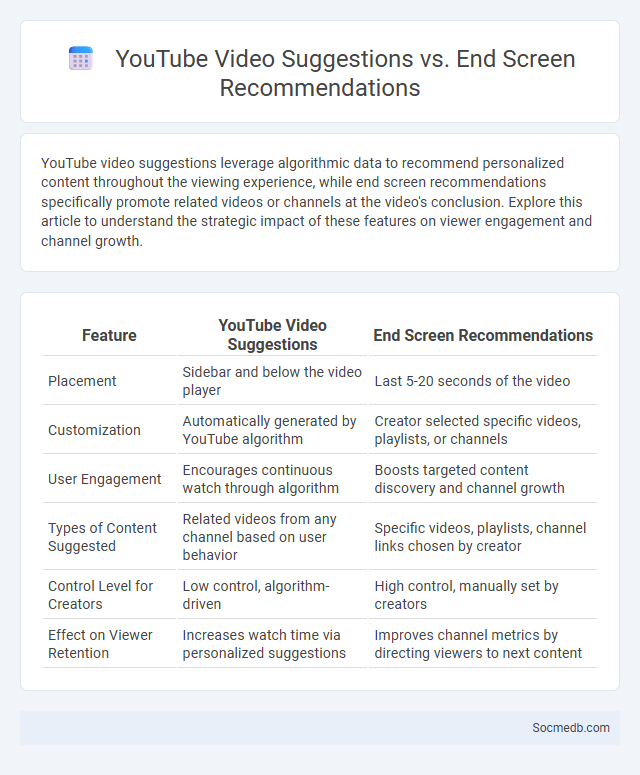
Photo illustration: YouTube Video Suggestions vs End Screen Recommendations
YouTube video suggestions leverage algorithmic data to recommend personalized content throughout the viewing experience, while end screen recommendations specifically promote related videos or channels at the video's conclusion. Explore this article to understand the strategic impact of these features on viewer engagement and channel growth.
Table of Comparison
| Feature | YouTube Video Suggestions | End Screen Recommendations |
|---|---|---|
| Placement | Sidebar and below the video player | Last 5-20 seconds of the video |
| Customization | Automatically generated by YouTube algorithm | Creator selected specific videos, playlists, or channels |
| User Engagement | Encourages continuous watch through algorithm | Boosts targeted content discovery and channel growth |
| Types of Content Suggested | Related videos from any channel based on user behavior | Specific videos, playlists, channel links chosen by creator |
| Control Level for Creators | Low control, algorithm-driven | High control, manually set by creators |
| Effect on Viewer Retention | Increases watch time via personalized suggestions | Improves channel metrics by directing viewers to next content |
Understanding YouTube's Recommendation Ecosystem
YouTube's recommendation ecosystem leverages advanced machine learning algorithms to personalize content based on user behavior, watch history, and engagement patterns. The platform prioritizes video relevancy, viewer retention, and satisfaction metrics to optimize suggestions, driving significant watch time and advertiser value. Continuous data analysis and feedback loops enable YouTube to adapt recommendations dynamically, enhancing user experience and content discoverability.
What Are YouTube Video Suggestions?
YouTube video suggestions are algorithm-driven recommendations that appear alongside or after a video, designed to keep viewers engaged by offering content related to their interests and viewing history. These suggestions use data such as watch time, video metadata, and user behavior to predict what videos You may want to see next. By optimizing your content with relevant keywords and engaging thumbnails, you can improve the likelihood that your videos will appear in these personalized recommendations.
The Role of End Screen Recommendations
End screen recommendations on social media platforms play a crucial role in increasing viewer retention and boosting content discoverability by suggesting related videos tailored to your interests. These recommendations utilize algorithms that analyze your viewing behavior, engagement patterns, and preferences to deliver personalized content, enhancing your overall user experience. By leveraging end screen suggestions, creators can extend watch time and foster stronger audience connections, directly impacting the platform's engagement metrics.
How General Recommendations Work on YouTube
General recommendations on YouTube utilize advanced machine learning algorithms to analyze your watch history, search queries, and engagement patterns to suggest relevant videos. The platform prioritizes content that aligns with your interests by evaluating factors such as video popularity, watch time, and user interaction metrics. These personalized recommendations aim to enhance your viewing experience by continuously adapting to your preferences and behaviors.
Placement and Visibility Differences
Social media placement varies significantly across platforms, influencing content visibility and user engagement. Paid placements on platforms like Facebook, Instagram, and LinkedIn offer targeted reach through sponsored posts and ads, while organic visibility depends on algorithmic ranking factors such as relevance, engagement, and timeliness. Understanding these placement differences enables marketers to optimize content strategies for maximum exposure and audience impact.
Algorithms Behind Each Recommendation Type
Social media platforms use machine learning algorithms to tailor content recommendations based on user behavior, interactions, and preferences. Collaborative filtering analyzes the activity of similar users to suggest posts, while content-based filtering evaluates your past engagements to recommend relevant topics. These algorithms continuously adapt, ensuring your feed remains personalized and engaging according to evolving interests.
Impact on Viewer Engagement and Watch Time
Social media platforms use algorithms designed to maximize viewer engagement by analyzing user behavior, preferences, and interactions to deliver personalized content. This targeted approach significantly increases watch time by presenting users with videos and posts that match their interests, encouraging longer and more frequent visits. Your engagement metrics, such as likes, comments, and shares, directly influence the visibility and reach of content, creating a feedback loop that further amplifies viewer retention.
Best Practices for Optimizing Video Suggestions
To enhance video suggestions on social media platforms, focus on optimizing metadata including titles, descriptions, and tags with relevant keywords that align with your content. Utilize engaging thumbnails and consistently upload high-quality videos tailored to your audience's interests to increase watch time and interaction. Analyzing viewer behavior and feedback allows you to refine your strategy, improving algorithmic ranking and delivering more personalized video recommendations for your viewers.
Leveraging End Screens for Maximum Benefits
Leveraging end screens on social media videos enhances viewer retention by directing audiences to additional content, playlists, or calls to action, increasing overall engagement. Incorporating clickable elements like subscribe buttons and video suggestions maximizes channel growth and boosts watch time metrics. Strategic placement and compelling design of end screens significantly improve click-through rates and foster deeper audience interaction.
Choosing the Right Strategy for Your Channel
Selecting the right social media strategy hinges on understanding your target audience's preferences and behavior on each platform. Tailoring content types and posting frequencies to the channel's unique algorithm enhances engagement and reach. Consistent analysis of performance metrics allows continuous optimization for better brand visibility and conversion rates.
 socmedb.com
socmedb.com